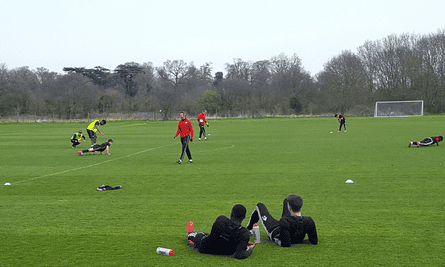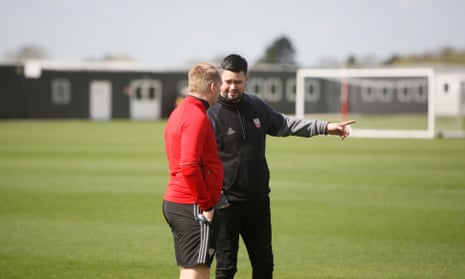It is a sunny Tuesday morning in west London and Robert Rowan, Brentford’s head of football operations, is watching Kevin O’Connor putting his B team squad through their paces. “Twenty-five press-ups for the strikers and then we go again,” commands the coach to his group of young players gathered from six European countries.
Almost a year on since the Championship club took the decision to close their youth academy as a response to the restrictions imposed on them by the Premier League’s elite player performance plan, this is the reality for Brentford. It is a radical three-year strategy designed to establish a way of developing players with the aim of “creating the most effective pathway into the first team of all English clubs”. It has already seen O’Connor’s hotchpotch team of former youth team players and recruits play Manchester United, Liverpool and Bayern Munich sides in friendlies this season, with four players having gone on to make their debut for Dean Smith’s first team.
“We discussed various different options when we were doing the review and we felt the B-team model was the one that gave us the best chance of producing first-team players,” Rowan says. “It allowed us far more flexibility on how we do that because we are not as restricted by regulation or rules. It was the most sustainable and effective option. It’s a lot easier to assess something that has got a turnaround of three years than over 10 years. Once that is over we will more than likely review again and see what we need to do differently to achieve our goal.”
In other words, at a cost of around £2m a year, Brentford decided it was simply too much of a risk that their academy – with so much competition on its doorstep in London – would produce enough first-team players to make that investment worthwhile. Instead they are focused on recruiting young players between 17 and 20 who have been released by academies in the Premier League, as well as talent from “undervalued markets” overseas.
“The first year is just the start-up stage but we’ve achieved more in terms of players making debuts than we believed we would, although we have also made mistakes in other areas,” says Rowan, who, at 24, was promoted to his current role when Mark Warburton left to join Rangers in 2015. “In the summer it was a new system and our model wasn’t really attractive to players because it was seen as a bit of a gamble. Now we’ve had one year of a very good games programme and a very efficient pathway which means we can clearly present how we develop players and the opportunities we can provide. The big challenge now is the turnover – if we do promote players and there are players out of contract, the next part of the job is bringing that new batch in so the cycle of recruitment is back to the start but the expectations in quality are a lot higher.
“We have a good understanding of what kind of player can be successful in England. Part of our recruitment process is identifying different leagues where the physical qualities are often overlooked in favour of the tactical qualities, whereas in England if you are physical you have a good chance of being a good player. The tactical side of things can be taught and we are confident we can provide an environment where they can learn those skills. It’s a lot easier in those undervalued markets to take a player and put him into our environment for the longer term. Our job is improving the understanding of all the markets that are out there and trying to identify potential stars.”
The youth team products Chris Mepham and Reece Cole, the German midfielder Jan Holldack and the striker Justin Shaibu – signed from the Danish side HB Koge for £40,000 last summer – are the B team players to have featured for the first team, with a further three having been included in a match-day squad. But at a time of year when most Premier League academies are making tough decisions about which young players to retain, Rowan admits it is crucial they get their research correct.
“We’ve been following some of these players for a year,” he says gesturing at one of several whiteboards dotted around his portable office at the training ground. “So, for instance, we know everything about every player in the under-18s at Tottenham. There isn’t much point in us going to scout young talent in lower league clubs as every Premier League club can out-spend and out-resource us. It’s actually a waste of resources/time for us, so instead we want to have in-depth knowledge on the ones who may be released from the big clubs.

“Then it’s about keeping up relationships so as soon as we get that decision [that they are being released], we are the first ones to be tipped off about it. The ideal situation for us is to get this squad complete before the season finishes. German clubs are great at having their recruitment done before the window is even open. They are very organised and efficient in their due diligence so we aim to work as hard as them. We only need to find four more players before we can go and have a holiday.”
Owned by Matthew Benham, whose company, Smartodds, provides statistical research and sports modelling advice to professional gamblers, Brentford’s B team are just the latest innovation at Griffin Park as the club attempt to reach the top flight for the first time since the second world war. Yet while Benham has rejected comparisons with the Moneyball approach made famous by the baseball coach Billy Beane at the Oakland As, the use of analytics remains a significant part of their approach. “I can’t really say too much – they’ll probably kill me!” Rowan says, laughing. “A lot of people seem to think this place is full of robots providing the recipe for success but there is no secret formula. The fact our directors of football have expertise in business means probably we are more process-driven than your average club.
“We’re fortunate with our owner’s background that we have access to resources that most clubs won’t have. What’s important is how we use those resources. We’ve spent time trying to understand that but we have got to a point now where we feel far more comfortable over how to use it all correctly. Hopefully we can start to reap some rewards now.”
Working under the co-directors of football Rasmus Ankersen and Phil Giles, Rowan has risen rapidly to prominence. Now 26, he was encouraged to pursue a career in football after reading an opposition scouting report compiled by the former Tottenham Hotspur manager André Villas-Boas, and sending his own version to every professional club in England and Scotland. Only three replied, including the Scottish champions, Celtic, where he was handed his first post scouting while still a teenager. After a spell at the Scottish Football Association where he met Warburton’s long-time assistant David Weir, he was employed by a bank when Benham invited him to join Brentford in 2014. Such has been his progress that Rowan was interviewed by Rangers for their vacant director of football post in February, although he insists his work at Brentford is far from complete.
Despite witnessing the fallout from the decision to close the youth academy, O’Connor, who joined the club as a 15-year-old, believes they could be on to something.
“The games programme has been brilliant. We couldn’t really ask for much more in terms of the opposition we have faced,” he says. “We’ve played some of the biggest teams in the country, which has also helped to get the fans interested. Now we need to get some players into the first team and they become regulars. The standard will definitely improve next year but it’s so important that we get that first player to come through the system.”
Despite initial opposition to the closure of the youth academy, more than 1,000 supporters were at Griffin Park for the 2-2 draw against Liverpool in September and the 3-2 win over Manchester United in November, with Manchester City scheduled for 15 May as the last of more than 30 B team friendlies. Each draw is resolved by a penalty shootout, while next season Rowan is hoping to introduce enough extra fixtures to replicate the Saturday, Tuesday, Saturday schedule of Smith’s first team.
“The development process has to be exciting. It can’t just be training and then a game on Saturday every week,” he says. “For our players it’s like: ‘Bloody hell, we are playing Man City this week.’ When we played against Bayern Munich we spent the next day at their training ground and then allowed them to train at our place after their Champions League game against Arsenal.
“That was a brilliant experience and that is more important than just turning up and playing games against the same teams under the same conditions. I think it’s important we learn from different sectors of society – the education system has developed so much over the last 15 years in areas purely related to the individual learning experience but academy football has never done anything different in the way we deliver the learning experience.”

Comments (…)
Sign in or create your Guardian account to join the discussion